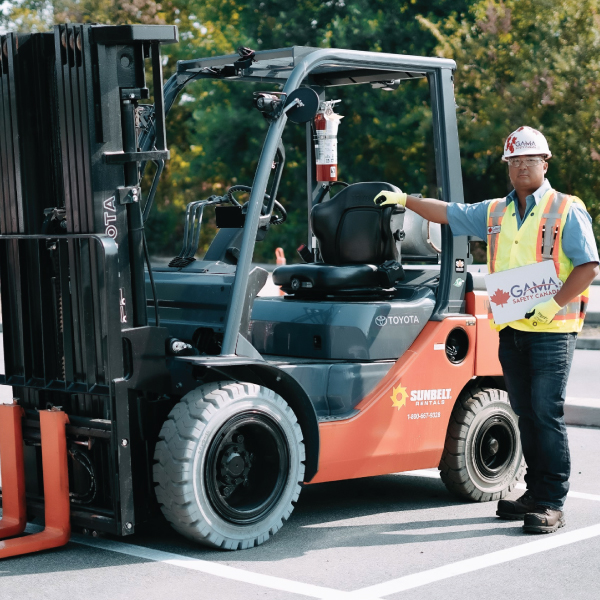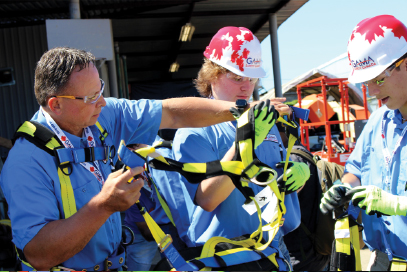Safe Operation and Handling
of SDCB Forklifts in Industrial Environments
The SDCB Forklift is designed for material handling in environments requiring heavy lifting and precise maneuvering. Operators must be trained to safely control these machines, including understanding load limits, proper stacking techniques, and navigating tight spaces to prevent accidents and damage to property.
Safe Operation and Handling
of SDCB Forklifts in Industrial Environments
The SDCB Forklift is designed for material handling in environments requiring heavy lifting and precise maneuvering. Operators must be trained to safely control these machines, including understanding load limits, proper stacking techniques, and navigating tight spaces to prevent accidents and damage to property.
OUR PARTNERS AROUND THE WORLD
OUR PARTNERS AROUND THE WORLD
Implementing Effective Fall Protection
Systems to Prevent Workplace Injuries
Fall Protection is essential for workers who perform tasks at height, such as construction or maintenance. Proper fall protection equipment and safety protocols, including harnesses, guardrails, and training, are critical in preventing serious injuries or fatalities due to falls in the workplace.
OUR PARTNERS AROUND THE WORLD
OUR PARTNERS AROUND THE WORLD
OUR PARTNERS AROUND THE WORLD
SDCB Forklift
Operation Basics
Learn the fundamental skills and safety checks required to operate a Sit-Down Counterbalance (SDCB) forklift effectively.
Advanced SDCB
Forklift Techniques
Explore advanced operating procedures and safety protocols for Sit-Down Counterbalance forklifts in various work environments.
Forklift Safety Resources
Guidance on common forklift accidents and prevention strategies in the workplace.
Information on forklift control systems and safe operating practices.
Safe practices for loading and unloading forklifts to prevent tipping and injury.
WorkSafeBC guidelines on forklift operation and compliance under Part 16 regulations.
Toolbox guide for conducting forklift inspections before each use.
WorkSafeBC video on staying safe while operating forklifts – stay in the cab, stay alive.
Staying Safe While Operating Industrial Lift Equipment
Operating a sit-down counterbalance (SDCB) forklift requires more than basic driving skills—it demands focused training, hazard awareness, and full understanding of the equipment. At GamaSafety, our training program equips operators with the knowledge and confidence to handle heavy loads safely, avoid tipping risks, and comply with Canadian safety standards in warehouse and construction environments.

SDCB FORKLIFT
SDCB Forklift Training:
Safe Operation and Hazard Prevention.
The Safe Driving Counterbalance (SDCB) forklift is one of the most commonly used machines in warehouses, construction sites, and industrial facilities. While essential for material handling, improper operation of an SDCB forklift can lead to serious workplace incidents, including collisions, tipping, and equipment damage.
At Gama Safety, our SDCB Forklift Training is designed to provide workers, supervisors, and employers with the knowledge and hands-on experience needed to operate this equipment safely and effectively.
Whether you're a new operator or need recertification, our instructor-led training ensures every participant is prepared to meet job site expectations and legal requirements. By the end of the course, students will be able to confidently and safely operate an SDCB forklift in real-world conditions protecting themselves, their coworkers, and company assets.
SDCB FORKLIFT Definition
An SDCB (Sit-Down Counterbalance) forklift is a powered industrial truck designed for lifting, moving, and stacking heavy materials in construction, warehouse, and industrial settings. The operator sits inside a protective cab and operates the machine using hand and foot controls.
The term counterbalance refers to the built-in weight at the rear of the forklift, which balances the weight of the load lifted at the front. This design eliminates the need for extended arms or outriggers, allowing for better maneuverability in tight indoor spaces.
SDCB forklifts are available with different power sources electric, propane, diesel and are used extensively for palletized goods, shipping operations, and material handling. Because of their weight distribution and capacity, these forklifts are highly effective but require proper training to operate safely and in compliance with Canadian safety standards.
The counterbalance design of SDCB forklifts is based on the principle of physics that uses a rear weight to stabilize loads carried at the front. This creates a “fulcrum” at the front axle, where the balance between the load, the forklift’s structure, and the counterweight must be maintained.
The operator must be trained to:
Understand load center and weight distribution
Never exceed the rated capacity of the forklift
Operate within the stability triangle, a concept used to describe the balance between three points: the front wheels and the center of gravity
Improper load handling or sudden movement can shift this balance and lead to tipping accidents, making it critical to master this principle during training.
SDCB forklifts are widely used in both indoor and outdoor environments where hard, even surfaces allow stable operation. Common industries and applications include:
Warehousing and distribution centers
Construction sites
Manufacturing plants
Shipping yards
Industrial supply and logistics hubs
Their compact design and seated controls make them ideal for long shifts and repetitive lifting tasks. However, they are less suitable for rough terrain or soft surfaces applications that would require rough-terrain or all-terrain forklifts.
A comprehensive understanding of the forklift’s key components is crucial for safe operation. These include:
Mast: Raises and lowers loads
Carriage and Forks: Carries the material load
Overhead Guard: Protects the operator from falling items
Counterweight: Balances the load
Operator Controls: Used for steering, lifting, and braking
Seat Belt & Safety Switches: Required for compliance with Canadian standards
Load Backrest: Helps support the load and prevents shifting
At GamaSafety, our training includes hands-on orientation with each of these parts, ensuring participants can safely inspect, identify issues, and operate their equipment confidently.
Operating an SDCB forklift is legally classified as a safety-sensitive task, which means certification is required by law in every province and territory in Canada. Employers must ensure operators are trained and evaluated before being authorized to use the equipment.
Certification includes:
A theoretical component (regulations, hazard awareness, equipment limitations)
A hands-on practical evaluation
Recognition of standards such as CSA B335 and OHSA requirements
At GamaSafety, our SDCB Forklift Certification program meets national and provincial standards, ensuring workers are trained to safely handle material loads, reduce workplace risks, and remain compliant with Canadian occupational safety law.
SDCB FORKLIFT Legislation
Forklift operation in Canada is regulated under a combination of federal and provincial occupational health and safety laws. These laws define the employer's legal duty to ensure that forklift operators:
Are properly trained and certified
Are supervised while operating powered industrial trucks
Work in a safe environment with properly maintained equipment
Relevant legislation includes:
OHSA – Ontario Health and Safety Act
WorkSafeBC – Occupational Health and Safety Regulation (Part 16)
Alberta OHS Code – Powered Mobile Equipment regulations
Non-compliance may result in penalties, fines, suspension of operations, or liability in the event of workplace injury.
The CSA B335 standard is the national reference for forklift training and safety. It outlines the full framework for:
Operator competencies
Instructor qualifications
Practical evaluation protocols
Equipment inspection and maintenance requirements
Documentation and recordkeeping
GamaSafety’s SDCB Forklift course is fully aligned with CSA B335, ensuring that every participant meets or exceeds expectations in both safety knowledge and practical execution. This standard is frequently referenced by provincial safety authorities during audits and workplace inspections.
According to Canadian law, employers must:
Ensure each forklift operator is certified and competent
Maintain up-to-date records of training and evaluations
Provide refresher training as needed (e.g., after an incident or observed misuse)
Conduct regular equipment inspections
Supply required PPE such as safety shoes, high-visibility clothing, and hearing protection
Failure to meet these requirements can result in regulatory citations, work stoppages, or litigation if an accident occurs. GamaSafety supports employers by delivering compliant training and helping them maintain essential records.
While CSA B335 is a national standard, enforcement of forklift safety laws is handled at the provincial level. Some regional specifics include:
Ontario (OHSA Reg. 851): Requires that forklifts are maintained in a condition that does not endanger any worker.
British Columbia (WorkSafeBC Part 16): Requires documented proof of operator competency and daily inspections.
Alberta (OHS Code Part 19): Requires pre-job hazard assessments and operator-specific evaluation.
GamaSafety customizes training to reflect the legal nuances of each province, ensuring companies and workers are always in full compliance, regardless of location.
All forklift training and certification in Canada must be documented to prove compliance during audits or inspections. Required records include:
Operator’s name and ID
Date of training and evaluation
Name and credentials of the trainer
Course content and results
Expiration date of certification (typically every 3 years)
GamaSafety provides official certificates upon course completion and assists companies in managing their internal training records, helping them stay organized, compliant, and audit-ready.
Other Courses You May Be Interested In.
Workers who complete SDCB FORKLIFT training often continue their safety education with the following programs:"
More Courses
Online Courses
"Explore & Book Online Courses!
Have a Question?
"We’re here to help! Click the button to get in touch."


